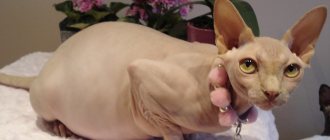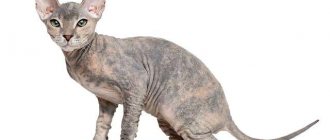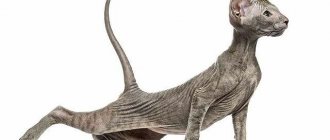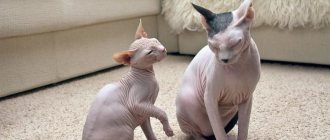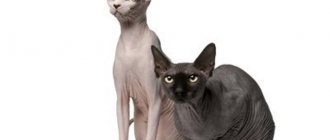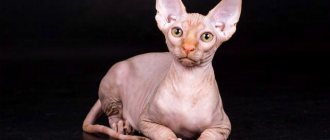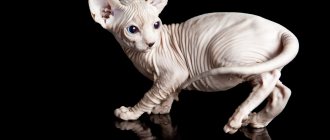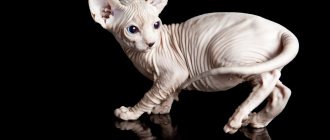The Don Sphynx is a fairly young breed of hairless cats, the appearance of which was the result of a spontaneous mutation, and not the deliberate crossing of existing hairless breeds.
Good-natured, slightly lazy and very intelligent, Russian Sphynxes quickly found their niche among many other breeds. The alien appearance and aristocracy have caught the hearts of cat lovers around the world.
History of the origin of the breed
The history of the Don Sphynx breed began when Rostov resident Elena Kovaleva, returning home in the evening, saw a trembling wet lump on the street, which, upon closer examination, turned out to be an emaciated stray cat. It is unknown whether we would know such a breed now if the heart of a kind woman had not taken pity on the poor creature. Elena took her home and named her Varvara.
The cat quickly settled into her new home, ate her fill, but began to rapidly lose her fur. The owner treated her pet with all sorts of drugs, sinning either for lichen, or dermatitis, or a lack of vitamins. Noticing that Varvara was not hampered by the lack of fur and that her health was more than good, Elena decided to consult with specialists. It turned out that this is a mutation at the gene level.
Having matured, Varvara gave birth to kittens by mating with an ordinary yard cat, and the entire litter inherited this genetic anomaly - a small fluff instead of fur, which eventually came out completely. Only one cat from this litter is known for certain, Chita, who ended up with Irina Nemykina. It was Irina who later became the first breeder of the new domestic breed.
The Don (Rostov) Sphynx is a cat that does not have common roots with the Canadian Sphynxes. However, the excitement around Canadians contributed to the popularization of the new breed, both in Russia and abroad.
Just a few years after the miraculous rescue of the unusual cat Varvara from the street, her descendants were already recognized by the international felinological association as an experimental cat breed (1992), the Don breed received official status in 1996.
The breed was named for its resemblance to ancient Egyptian cats and the name of the region in which it began to be bred. Among other options, there were such as “Scythian”, “dandelion”, “Cossack”, “nu”.
Feeding the cat
Hairless cats have faster metabolic processes than other breeds. They need more calories to maintain their body temperature.
Complete diet
When feeding dry formulas, preference is given to super-premium or holistic food from the following brands:
Some cat owners choose natural food for their pets. In this case, the Sphinx’s diet includes:
- lean meats - rabbit, veal, turkey, chicken;
- sea fish;
- cereals cooked in water without salt - buckwheat, rice, oatmeal;
- fermented milk products – low-fat cottage cheese, yogurt, sour cream;
- vegetables that have undergone heat treatment - carrots, broccoli, spinach;
- quail or chicken eggs (no more than 2 times a week).
Sphynx cats should not be fed processed foods, sausages, snacks, smoked meats, sweets, pork, bones and potatoes.
Feeding frequency
Adult cats are fed 2 times a day - morning and evening. During the daytime, you can treat the sphinx with a small piece of treat. Small kittens should eat more often:
- from 1 to 3 months – 6 times a day;
- from 3 to 6 months – 4 times a day;
- from 6 to 9 months – 3 times.
Vitamins and minerals
There is no need to additionally introduce mineral and vitamin supplements into the Sphynx's diet if he eats high-quality industrial food.
Feeding is needed for cats that eat natural food. Complex preparations with vitamins must be given in courses 2 times a year. In order not to harm the health of the sphinx, you first need to show it to the veterinarian.
Description and breed standard
The description of the Don Sphynx breed must begin with its distinctive feature, that is, the absence of hair. Unlike Canadians, naked cats are completely deprived of it. The skin is very pleasant to the touch - it is hot and velvety. It gathers in folds on the paws, belly and groin, this is especially pronounced in kittens.
The breed standard provides for 4 types of skin:
- naked (completely devoid of hair, skin resembles human skin, only hotter);
- flock (there is a barely noticeable fluff, it feels like the skin of a peach or apricot);
- velor (the length of the soft plush pole is no more than 2-3 mm, it may disappear with age);
- brush (has hard, short, curly hair, similar in appearance to lamb).
Brush sphinxes are not exhibited and do not have titles, but they are very important for breeding work, since with their participation the likelihood of the occurrence of genetic diseases is significantly reduced.
The Don Sphynx cat breed is elegant, graceful and noble. It’s hard to imagine that she came from an ordinary yard Varka.
- The body is muscular, slender, and has a fairly wide bone structure.
- The head is triangular, medium in size.
- The ears are large, also triangular in shape, with rounded tips.
- The eyes are expressive, slightly slanted, shaped like two tonsils. Eye color can be hazel, green, blue, yellow.
- Don Sphynxes have a small, neat nose.
- The whisker pads are pronounced; eyebrows and mustaches may be present in small quantities or may be absent altogether.
- The paws and tail are elongated, flexible, giving grace and lightness to the gait. The hind legs are slightly longer than the front legs. The paw pads are oblong, the toes appear long and thin due to the lack of hair.
- The tail is similar in appearance to a mouse.
An interesting feature of the Don Sphynx breed is the periodic appearance of soft fluff on their delicate skin, which can disappear from time to time. These metamorphoses are associated with the weather and time of year, with hormonal levels and even with a change in diet.
Parameters, size and weight of the Don Sphynx
The Don Sphynx has pronounced sexual demorphism. Males are much larger, the weight of a male can reach 7 kg, females are usually smaller from 3.5 to 5 kg. Still, the Don Sphynx breed can be considered average, like most ordinary cats.
Health
Canadian Sphynx cats have good immunity and, with proper care, live an average of 13-14 years. Like any other animals, these cats have a predisposition to certain pathologies.
Most often, the following diseases are diagnosed in Canadian Sphynx cats:
- myopathy;
- hypertrophic cardiomyopathy;
- airway obstruction;
- turning of the eyelids;
- breast cyst;
- dermatitis;
- acne;
- inflammation of blood vessels;
- gum hyperplasia;
- skin cancer;
- urticaria pigmentosa.
Character
The character of the Don Sphynx is distinguished by good nature, affection, and tender affection for its owner. This breed has nobility, self-esteem and will not tolerate familiarity in relation to its person. Cats position themselves as full members of the family, and not pets dependent on the owner.
In childhood, kittens show amazing curiosity, hyper activity and good learning ability. As they grow older, their ardor becomes more moderate every month, and in adulthood they are calm, balanced animals with a stable psyche and a complete lack of aggression.
The Don Sphynx can behave inappropriately and become truly angry only if it is greatly frightened by something. Cases of such behavior are rare and do not characterize the breed as a whole.
Cats love a measured, unhurried lifestyle. They are perfect for living in a family of elderly people, but they can also get along with small children and will quickly get used to the constant noise. The same applies to other pets: they feel great in the company of other cats, as well as dogs, rodents, and birds.
Surprisingly, the character of the Don Sphynx is more reminiscent of a dog, and in some matters even human. They are not vindictive, smart and endowed with high intelligence.
Don Sphynx cats are excellent psychologists and quickly understand family relationships and its hierarchy. They choose their owner themselves, usually the head of the family, but they treat the rest of the household kindly, but with some condescension.
The favorite pastime of an adult cat of the Don Sphynx breed is to bask somewhere in a warm, secluded place or in the arms of the owner, or to watch all the household chores, sitting on a hill.
Hairless cats often like to lie on laptops, system units and, of course, batteries. At night they sleep mostly in the master's bed under a blanket.
Don Sphynxes, like other hairless cats, absolutely cannot stand loneliness. You should not get this breed if all family members are at work from morning to night - the cat will be very sad.
Raising a pet
To prevent your pet from sharpening its claws on furniture, buy him a scratching post.
Canadians require a lot of attention from their owners. You need to play and communicate with them a lot. When raising a dog, the owner must be patient. You should not shout at the animal and punish it, because the sphinx may be offended and stop trusting. During training, it is better to use the reward method. At the moment when the cat does what is required of her, you need to give her a treat.
Sphinxes have high intelligence. They can learn to fetch a ball, open a door, and follow other commands. Tailed animals will easily remember what a tray and scratching post are needed for if the owner carefully, without showing aggression, trains the pet.
Maintenance and care
Caring for the Don Sphynx is no different from caring for other hairless breeds. First of all, you need to create comfortable conditions for your pet, that is, a warm room, without drafts, equipped with beds, a scratching post and other related items. If the air in the apartment is cool, you need to dress your ward in soft blouses or overalls.
Ear hygiene is a separate topic in matters of care and maintenance of Don Sphynxes. A large amount of wax accumulates in the ears, which must be removed regularly. For these purposes, you can use cotton swabs soaked in a special ear cleaner. If such procedures are not carried out regularly, complications are possible (otitis media, infections, wax plugs).
The pet's skin should be wiped with wet wipes every day, more often in hot weather. And the Don Sphynx also needs to be washed sometimes. Like most hairless cats, they love water and enjoy bathing. People unfamiliar with the breed may not realize that cats sweat, and the color of the sweat is dark brown.
If you don't take care of your pet's skin, you can say goodbye to white bedding, light sofas and armchairs. Wherever an unwashed, neglected cat sits, dark spots will remain.
What to feed the Don Sphynx
The diet of the Don Sphynx should be varied. You can purchase premium cat food for hairless cats, in which all the necessary substances are as balanced as possible. The main thing is to buy food from the same brand so that the animal does not develop allergies or stomach upsets.
Food for the Don Sphynx can be natural, in which case you need to create your pet’s menu yourself. Meat, fish, low-fat cottage cheese and other protein-rich foods are the basis of the diet. In addition, you need to give vegetables, fruits, and cereals. You can also feed the Don Sphynx with offal, eggs, shrimp and other seafood.
Interesting Facts
For those interested in Sphynxes, here are a few facts about these cute cats:
- They have an excellent appetite, as their body quickly gives off heat.
- Hairless cats come in different colors and even patterns on their bodies in the form of spots or stripes.
- Although the Sphynx seems too hot, its body temperature is almost the same as that of representatives of other breeds, only 0.5 degrees higher.
- A hairless cat can easily learn to open door handles and perform other manipulations.
- The Canadian Sphynx is not suitable for allergy sufferers.
Mating and breeding
Cats reach puberty at six months of age, males a little later - at 8 months. However, the first mating of Don Sphynxes occurs no earlier than 18-24 months, usually during the 3rd heat period. It is not recommended to mate naked-born representatives of this breed, since the offspring will be weak.
On the third day after the start of estrus, the cat is placed in the cat’s territory, where she spends about 3 days. Pregnancy lasts 58-72 days, after which 3-6 babies are born. Newborn Don Sphynx kittens are the most vulnerable, although they are born with a small amount of fluff.
A cat giving birth for the first time needs to be with you throughout the entire birth process. She must eat the afterbirth and lick each kitten. How long the first birth will last depends on how many kittens she gives birth to. In general, Don Sphynx cats give birth quickly and without complications.
Cats of this breed are very caring mothers and take almost all care of the kittens themselves. All a person can do is monitor their health. Periodically wipe the eyes with a weak solution of potassium permanganate to prevent souring.
When Don Sphynx kittens begin to go bald, you need to exclude possible drafts and monitor the temperature in the room, otherwise the kids may catch a cold.
You need to care for a Don Sphynx kitten in the same way as kittens of other breeds, but take into account the characteristics of their skin and ears.
How long do Don Sphynxes live?
With proper care, regular vaccinations and a balanced diet, the life expectancy of the Don Sphynx is no different from most domestic cats. On average it is 12-14 years. Some Don Sphynxes can live up to 18 years.
Prices for Canadian Sphynxes
Sphynxes are sold in specialized nurseries. This is due to the fact that they are extremely difficult to breed. Kittens are taken from the cat at 3 months, which makes it possible to avoid significant stress in young pets. At the same time, at 3 months of age, animals begin to be vaccinated.
The cost of cats depends on the pedigree and purity of the blood, appearance and character of the pet. The minimum cost for Canadians in Moscow is about 7500-8000 rubles. The price of purebred animals reaches 100-150 thousand rubles.
How much does it cost and how to choose a kitten
Buying these animals is not difficult, since in Russia, their homeland, they are most widespread.
Pet-class Don Sphynx kittens cost about 10-15 thousand. They cannot qualify for prizes at exhibitions and do not participate in breeding, but they are excellent as pets.
The Breed class will cost more, not to mention the show class, a copy of which will cost at least $1,500. Such kittens are rarely purchased and only by people who have a certain commercial interest in the breed.
You should not buy a kitten from someone else or from an advertisement. In our country there are enough worthy and proven nurseries that have been successfully breeding Don Sphynxes for decades. Upon external examination, the animal should not be lethargic, thin or apathetic. The presence of a veterinary passport with vaccination marks is a mandatory condition for purchase.
brief information
Don Sphynxes are very gentle, heat-loving animals. They are affectionate, sociable and loyal, like dogs. They will follow the owner's heels and wait for an opportunity to jump on his lap. These smart, obedient and inquisitive pets are popular among cat lovers. Their softness and docile nature is unusual for cats. They give a lot of joy and love, get along well with other cats and dogs, and are friendly with strangers.
Because of their original appearance, some people consider Donchak people to be ugly. Not everyone likes his smooth skin without hair, but with a lot of folds. But the muzzle attracts attention with large ears and almond-shaped intelligent eyes. Because of this “unearthly” appearance, the breed has many fans.
Catering
Babies aged 3-5 months eat 4-5 times a day, gradually the number of meals is reduced. A kitten older than 6 months eats 2 times a day.
Pictured are kittens of the Canadian Sphynx breed
Recommended food
Sphynx cats need to be fed holistic or super-premium food. These are Acana, Fitmin For Life, Brit Care, Blitz. This is high-quality food containing: fresh meat and meat ingredients, vegetables, oats, barley or rice, mixtures of tocopherols, rosemary and other useful ingredients.
Below are recommended super-premium foods. Links with the names of the food are clickable, on them you can, within our website, get acquainted with the descriptions of the food and read reviews from owners of Sphynx cats.
| Super premium | Super premium | Super premium |
| Leonardo | Superpet | Organix |
Premium and economy classes for the Sphinx are not worth taking. These foods contain a lot of vegetable protein (which is poorly digestible), unknown preservatives and antioxidants, and instead of meat - meat waste and tripe.
Weight table by month
There are no giants among the sphinxes, and large individuals are extremely rare there. Males usually weigh no more than 7 kg; the weight of a female Sphynx barely reaches 4. Outwardly, they seem fragile and light, but once you pick up a cat, you will be surprised. Hidden under the skin are dense, elastic muscles and strong bones.
| Age | Cat (kg) | Cat (kg) |
| Newborn | 0.07-0.08 | 0.1-0.11 |
| 1 month | 0.4-0.5 | 0.5-0.65 |
| 2 | 0.9-1 | 1.2-1.3 |
| 3 | 1.5-1.6 | 1.8-2 |
| 4 | 1.9-2 | 2.2-2.5 |
| 5 | 2.2-2.8 | 2.3-2.8 |
| 6 | 2.6-2.9 | 2.7-3 |
| 7 | 2.7-3 | 3.1-3.6 |
| 8 | 3.1-3.3 | 3.7-4.4 |
| 9 | 3.2-3.5 | 4.3-4.8 |
| 11 | 3.4-3.8 | 5-5.7 |
| 1 year | 3.7-4.1 | 6-6.8 |
| 2 and older. . . | 4-4.3 | 6.7-7.2 |
Diseases
Sphinxes have good immunity, but there is a whole list of hereditary diseases. Therefore, you will need to find a good veterinarian as soon as you bring a kitten into your home.
- Hypertrophic cardiomyopathy - this disease is expressed by hardening of the walls of the heart ventricle and without timely treatment leads to early death. You cannot get rid of it, but with the help of medications you can significantly improve your quality of life and prolong it.
- “Carp bite” is a shortening of the lower jaw. If the pathology is mild, the cat adapts well to it. In difficult cases, surgery is required.
- Microphthalmos is underdevelopment of the eye. Leads to the appearance of cataracts, keratitis, and decreased visual acuity.
- Inward turning of the eyelids is a physical defect that causes a series of inflammatory processes and conjunctivitis. Minor surgical correction is allowed.
- Curvature of the spine, or only the caudal region. It occurs frequently, and sometimes in combination there is an abnormality of intestinal development, underdevelopment of the vertebrae, or dwarfism.
- Thymus underdevelopment is a fatal disease. Alas, it can neither be predicted nor cured. Kittens die a few days after birth. The reason is the same - inbred crossing.
Even if your pet does not leave the house, it is necessary to carry out deworming and vaccinations on schedule. This will save your pet from harm, because pathogens can be brought home on outdoor shoes, clothes and hands. Before petting your cat, be sure to wash your hands thoroughly!
Colors
- black (nose black, like paw pads, skin slate gray);
- blue (light blue skin color with a silver tint, slate-colored nose, light gray paws);
- chocolate (nose and skin - all shades of chocolate, paw pads pinkish);
- lilac (silver with pale pink skin, nose and paws);
- white;
- cream (shades of pink);
- red (pink to bright red).
Bicolor: Any of the above with pure white. In this case, one ear should be painted over, preferably a bright spot on the top of the head.
Van: the cat is white, the tail is colored, there is a bright spot on the head that extends to the ears. The paws and nose are pale pink.
In the photo there are cats of the Canadian Sphynx breed, van and bicolor colors
Harlequin: a cross between a van and a bicolor. There is a spot on the top of the head, an ear catcher, a few spots on the body, and speckles on the legs and tail are allowed. Pink paw pads and nose.
Siamese color (color point): cream point, seal point, chocolate point, lynx point (tabby).
In the photo there is a cat of the Canadian Sphynx breed, Siamese color and harlequin
